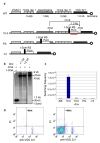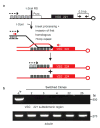A yeast-endonuclease-generated DNA break induces antigenic switching in Trypanosoma brucei
- PMID: 19369939
- PMCID: PMC2688456
- DOI: 10.1038/nature07982
A yeast-endonuclease-generated DNA break induces antigenic switching in Trypanosoma brucei
Abstract
Trypanosoma brucei is the causative agent of African sleeping sickness in humans and one of the causes of nagana in cattle. This protozoan parasite evades the host immune system by antigenic variation, a periodic switching of its variant surface glycoprotein (VSG) coat. VSG switching is spontaneous and occurs at a rate of about 10(-2)-10(-3) per population doubling in recent isolates from nature, but at a markedly reduced rate (10(-5)-10(-6)) in laboratory-adapted strains. VSG switching is thought to occur predominantly through gene conversion, a form of homologous recombination initiated by a DNA lesion that is used by other pathogens (for example, Candida albicans, Borrelia sp. and Neisseria gonorrhoeae) to generate surface protein diversity, and by B lymphocytes of the vertebrate immune system to generate antibody diversity. Very little is known about the molecular mechanism of VSG switching in T. brucei. Here we demonstrate that the introduction of a DNA double-stranded break (DSB) adjacent to the approximately 70-base-pair (bp) repeats upstream of the transcribed VSG gene increases switching in vitro approximately 250-fold, producing switched clones with a frequency and features similar to those generated early in an infection. We were also able to detect spontaneous DSBs within the 70-bp repeats upstream of the actively transcribed VSG gene, indicating that a DSB is a natural intermediate of VSG gene conversion and that VSG switching is the result of the resolution of this DSB by break-induced replication.
Figures




Comment in
-
Molecular microbiology: A key event in survival.Nature. 2009 May 14;459(7244):172-3. doi: 10.1038/459172a. Nature. 2009. PMID: 19444197 No abstract available.
Similar articles
-
Molecular microbiology: A key event in survival.Nature. 2009 May 14;459(7244):172-3. doi: 10.1038/459172a. Nature. 2009. PMID: 19444197 No abstract available.
-
Antigenic diversity is generated by distinct evolutionary mechanisms in African trypanosome species.Proc Natl Acad Sci U S A. 2012 Feb 28;109(9):3416-21. doi: 10.1073/pnas.1117313109. Epub 2012 Feb 13. Proc Natl Acad Sci U S A. 2012. PMID: 22331916 Free PMC article.
-
Telomere length affects the frequency and mechanism of antigenic variation in Trypanosoma brucei.PLoS Pathog. 2012;8(8):e1002900. doi: 10.1371/journal.ppat.1002900. Epub 2012 Aug 30. PLoS Pathog. 2012. PMID: 22952449 Free PMC article.
-
Escaping the immune system by DNA repair and recombination in African trypanosomes.Open Biol. 2019 Nov 29;9(11):190182. doi: 10.1098/rsob.190182. Epub 2019 Nov 13. Open Biol. 2019. PMID: 31718509 Free PMC article. Review.
-
A Host-Pathogen Interaction Reduced to First Principles: Antigenic Variation in T. brucei.Results Probl Cell Differ. 2015;57:23-46. doi: 10.1007/978-3-319-20819-0_2. Results Probl Cell Differ. 2015. PMID: 26537376 Review.
Cited by
-
TbTRF suppresses the TERRA level and regulates the cell cycle-dependent TERRA foci number with a TERRA binding activity in its C-terminal Myb domain.Nucleic Acids Res. 2021 Jun 4;49(10):5637-5653. doi: 10.1093/nar/gkab401. Nucleic Acids Res. 2021. PMID: 34048580 Free PMC article.
-
Telomere maintenance in African trypanosomes.Front Mol Biosci. 2023 Nov 24;10:1302557. doi: 10.3389/fmolb.2023.1302557. eCollection 2023. Front Mol Biosci. 2023. PMID: 38074093 Free PMC article. Review.
-
DNA break site at fragile subtelomeres determines probability and mechanism of antigenic variation in African trypanosomes.PLoS Pathog. 2013 Mar;9(3):e1003260. doi: 10.1371/journal.ppat.1003260. Epub 2013 Mar 28. PLoS Pathog. 2013. PMID: 23555264 Free PMC article.
-
Genomic comparison of Trypanosoma conorhini and Trypanosoma rangeli to Trypanosoma cruzi strains of high and low virulence.BMC Genomics. 2018 Oct 24;19(1):770. doi: 10.1186/s12864-018-5112-0. BMC Genomics. 2018. PMID: 30355302 Free PMC article.
-
A DOT1B/Ribonuclease H2 Protein Complex Is Involved in R-Loop Processing, Genomic Integrity, and Antigenic Variation in Trypanosoma brucei.mBio. 2021 Dec 21;12(6):e0135221. doi: 10.1128/mBio.01352-21. Epub 2021 Nov 9. mBio. 2021. PMID: 34749530 Free PMC article.
References
-
- Horn D, Cross GAM. Analysis of Trypanosoma brucei vsg expression site switching in vitro. Mol Biochem Parasitol. 1997;84:189–201. - PubMed
-
- Turner CM. The rate of antigenic variation in fly-transmitted and syringe-passaged infections of Trypanosoma brucei. FEMS Microbiol Lett. 1997;153:227–31. - PubMed
-
- Berriman M, et al. The genome of the African trypanosome Trypanosoma brucei. Science. 2005;309:416–22. - PubMed
-
- de Lange T, Borst P. Genomic environment of the expression-linked extra copies of genes for surface antigens of Trypanosoma brucei resembles the end of a chromosome. Nature. 1982;299:451–3. - PubMed
Publication types
MeSH terms
Substances
Grants and funding
LinkOut - more resources
Full Text Sources
Other Literature Sources
Research Materials

